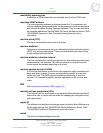
- 108 -
List of terms
Nortel Multiservice Switch 7400/15000/20000
Terminology
NN10600-005 7.2S1 Standard
PCR7.2 and up March 2006
Copyright © 2006, Nortel Nortel Confidential
provisioning data
The data that is entered to configure Nortel Multiservice Switch modules. In
other systems, it has been known as service data, configuration data, or
tables.
provisioning journaling
Represents the journaling of configuration changes on the disk. The journal
log files that result from provisioning journaling represent the configuration
changes between the current and committed views and can be used by Nortel
Multiservice Data Manager to backup the current view off-switch.
proxy alarm
An alarm that the Nortel Multiservice Data Manager generates on behalf of a
device (for example, a Nortel Multiservice Switch node) to report an event or
condition that, while detected by the Multiservice Data Manager, could either
not be indicated by the device itself (for example, a loss of module access), or
was reported through another non-alarm means (for example, OSI State
Change, SNMP polling, or a trap). Since the proxy alarm is generated by a
Multiservice Data Manager machine, two Multiservice Data Managers
managing the same devices may generate similar but not identical proxy
alarms for the same situation (that is, the notificationId value and time-stamps,
if not available in the triggering notification, may not match between the two
proxies). A redundantly configured Multiservice Data Manager is built to
correctly handle this situation.
proxy ARP
A system by which a router responds to an ARP request in place of the actual
destination.
PTSE
See PNNI topology state element (page 103).
PSTN
See public switched telephone network (PSTN) (page 108).
PTSP
See PNNI topology state packet (page 103).
public switched telephone network (PSTN)
The worldwide voice telephone network accessible to all those with telephone
and access privileges. The PSTN is composed of all transmission and
switching facilities and signal processors supplied and operated by all
telecommunications common carriers for use by the public. Every station on
the PSTN is capable of being accessed from every other station on the PSTN
via the use of NANP E.164 numbers. PSTN is an abbreviation defined by the
ITU-T.


















